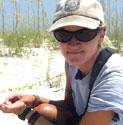Raya Pruner, M.S. (May 2010)
Email: raya.pruner@gmail.com
 Raya
Pruner completed a Master of Science degree in Wildlife Ecology and
Conservation at the University of Florida in May 2010. Her research
focused on the Cuban Snowy Plover (Charadrius alexandrinus
tenuirostris) a state-threatened species in Florida that nests
along the Gulf Coast. Raya’s research focuses on brood foraging
behavior, habitat use, and the factors affecting chick survival. The
goal of the study was to quantify the relationship between habitat
quality and brood success to allow for evaluation of the effects of
coastal engineering projects (beach renourishment, armoring, and/or
inlet management) on Snowy Plover foraging and brood rearing habitat.
Her research will provide valuable information for use in managing and
conserving the remaining 220 pairs currently nesting on Florida’s
beaches. Raya is currently working with the Florida Department of
Environmental Protection as the Panhandle Shorebird Coordinator.
Raya
Pruner completed a Master of Science degree in Wildlife Ecology and
Conservation at the University of Florida in May 2010. Her research
focused on the Cuban Snowy Plover (Charadrius alexandrinus
tenuirostris) a state-threatened species in Florida that nests
along the Gulf Coast. Raya’s research focuses on brood foraging
behavior, habitat use, and the factors affecting chick survival. The
goal of the study was to quantify the relationship between habitat
quality and brood success to allow for evaluation of the effects of
coastal engineering projects (beach renourishment, armoring, and/or
inlet management) on Snowy Plover foraging and brood rearing habitat.
Her research will provide valuable information for use in managing and
conserving the remaining 220 pairs currently nesting on Florida’s
beaches. Raya is currently working with the Florida Department of
Environmental Protection as the Panhandle Shorebird Coordinator.
Publications
Thesis (Full-text link below abstract)
CONSERVATION AND MANAGEMENT OF THE SNOWY PLOVER ALONG THE FLORIDA GULF COAST: HABITAT SELECTION AND THE CONSEQUENT REPRODUCTIVE PERFORMANCE
To expand upon the current ecological knowledge of Snowy Plovers, I studied breeding Snowy Plovers nesting along the Florida panhandle during 2008-09. I contrasted four alternative hypotheses (prey availability, human activity, predator activity, and physical features of the habitat) and the influence each had on habitat selection and reproductive performance during both the nesting and brood-rearing stages of breeding. I modeled the probability of selection and the daily survival rates as a function of predictors representing each hypothesis by breeding stage (i.e., nesting, brood-rearing). Nest-site selection and daily nest survival were a function of all four hypotheses working in combination. In contrast, brood-site selection was a function of prey availability alone and daily brood survival was a function of prey availability, predator activity, and physical features combined. Collectively, this information will provide for habitat management that will benefit the Snowy Plover. Additionally, my results provide a unique demonstration of how multiple selective forces influence site selection and reproductive performance that is relevant to wildlife in general.
- Pruner, R.A. 2010. Conservation and management of the Snowy Plover along the Florida Gulf Coast: habitat selection and the consequent reproductive performance (919 KB PDF) M.S. Thesis, University of Florida.